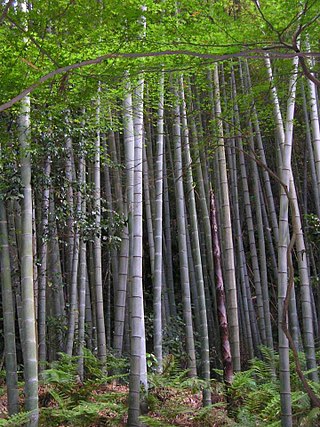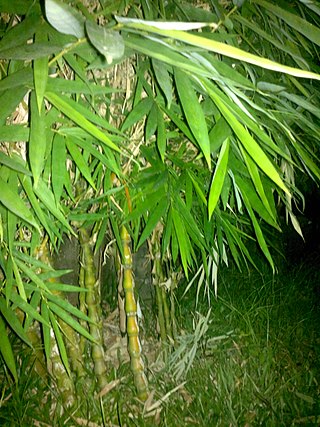
Bamboos are a diverse group of mostly evergreen perennial flowering plants making up the subfamily Bambusoideae of the grass family Poaceae. Giant bamboos are the largest members of the grass family, in the case of Dendrocalamus sinicus having individual stalks (culms) reaching a length of 46 meters (151 ft), up to 36 centimeters (14 in) in thickness and a weight of up to 450 kilograms (1,000 lb). The internodes of bamboos can also be of great length. Kinabaluchloa wrayi has internodes up to 2.5 meters (8 ft) in length. and Arthrostylidium schomburgkii has internodes up to 5 meters (16 ft) in length, exceeded in length only by papyrus. By contrast, the stalks of the tiny bamboo Raddiella vanessiae of the savannas of French Guiana measure only 10–20 millimeters (0.4–0.8 in) in length by about 2 millimeters (0.08 in) in width. The origin of the word "bamboo" is uncertain, but it probably comes from the Dutch or Portuguese language, which originally borrowed it from Malay or Kannada.

The Bambuseae are the most diverse tribe of bamboos in the grass family (Poaceae). They consist of woody species from tropical regions, including some giant bamboos. Their sister group are the small herbaceous bamboos from the tropics in tribe Olyreae, while the temperate woody bamboos (Arundinarieae) are more distantly related. The Bambuseae fall into two clades, corresponding to species from the Neotropics and from the Paleotropics.

Yunnan cuisine, alternatively known as Dian cuisine, is an amalgam of the cuisines of the Han Chinese and other ethnic minority groups in Yunnan Province in southwestern China. As the province with the largest number of ethnic minority groups, Yunnan cuisine is vastly varied, and it is difficult to make generalisations. Many Yunnan dishes are quite spicy, and mushrooms are featured prominently. Flowers, ferns, algae and insects may also be eaten. The cuisine of Yunnan is often compared to the cuisine of Southeast Asia as the province borders the region and many of the ethnic minorities or related cultural groups also have a presence in Southeast Asia.

Cephalostachyum is a genus of Asian and Madagascan bamboo in the grass family.
Melocanna is a genus of Asian clumping bamboo in the grass family.

Ochlandra is a genus of Indian bamboo in the grass family).

Schizostachyum is a tall or shrub-like tropical genus of bamboo. They are natives mostly of tropical Asia and Papuasia, with a few species in Madagascar and on certain islands in the Pacific. A few have become naturalized in other tropical regions.

The Lâm Viên Plateau is a plateau in southeastern Vietnam. At its centre is the city of Da Lat. Several mountains in this area rise to over 2,000 m (6,562 ft), the highest being Chư Yang Sin Summit at 2,442 m (8,012 ft).

Schizostachyum glaucifolium, common name Polynesian ʻohe, is a species of bamboo.

Oxytenanthera is a genus of African bamboo. Bamboos are members of the grass family Poaceae.

The flora of China consists of a diverse range of plant species including over 39,000 vascular plants, 27,000 species of fungi and 3000 species of bryophytes. More than 30,000 plant species are native to China, representing nearly one-eighth of the world's total plant species, including thousands found nowhere else on Earth. China's land, extending over 9.6 million km, contains a variety of ecosystems and climates for plants to grow in. Some of the main climates include shores, tropical and subtropical forests, deserts, elevated plateaus and mountains. The events of the continental drift and early Paleozoic Caledonian movement also play a part in creating climatic and geographical diversity resulting in high levels of endemic vascular flora. These landscapes provide different ecosystems and climates for plants to grow in, creating a wide variety of different flora spanning over not just China, but different parts of the world.

Bamboo shoots or bamboo sprouts are the edible shoots of many bamboo species including Bambusa vulgaris and Phyllostachys edulis. They are used as vegetables in numerous Asian dishes and broths. They are sold in various processed shapes and are available in fresh, dried, and canned versions.
Schizostachyum lima is a species of flowering plant in the family Poaceae. It is a bamboo that in Tagalog is commonly called anos / bokawe / bocaue, and in Cebuano: bagakay. It is propagated using seeds or rhizome cuttings. In the Philippines, it is often used for making sawali, fishing rods, and musical instruments. In some rural areas of the country, midwives still use sharp knives made of Schizostachyum lima to cut the newborn's umbilical cord.

Engleromyces sinensis is a species of fungus in the family Xylariaceae. It was described as new to science in 2010, based on specimens collected in 1958 and incorrectly identified as Engleromyces goetzii. The fungus is known only from China, where it grows on bamboo culms. It forms fruit bodies in the shape of two roughly circular buff-colored lobes measuring up to 50 cm (20 in) in diameter that envelop the bamboo. E. sinensis has been used as a folk remedy against cancer and infection in Tibet, Yunnan, and Sichuan Provinces. Several bioactive metabolites have been isolated and identified from the fungus.

Thyrsostachys siamensis is one of two bamboo species belonging to the genus Thyrsostachys. It grows up to 7 to 13m tall. It is native to Yunnan, Myanmar, Laos, Thailand, Vietnam and naturalised in Sri Lanka, Bangladesh, Malaysia. The plant is also known as long-sheath bamboo, monastery bamboo, Thai bamboo, Thai umbrella bamboo, umbrella bamboo, and umbrella-handle bamboo.
Hypericum addingtonii is a shrubby species of flowering plant in the family Hypericaceae. It is native to China and was described by Norman Robson in 1985.
Soejatmi Dransfield is an Indonesia-born British plant taxonomist specializing in bamboos and currently honorary research fellow at the Royal Botanic Gardens, Kew, UK.
Floyd Alonzo McClure was an American botanist and plant collector. He was one of the world's leading experts on bamboo and worked in China for 24 years.
Pseudobambusa schizostachyoides is a species of bamboo in the monotypic genus Pseudobambusa, of the tribe Bambuseae. No subspecies are listed in the Catalogue of Life.
Rubroshiraia is a monotypic genus of the family Shiraiaceae. Its only species, Rubroshiraia bambusae, is a bamboo-dwelling fungus native to China. It and its genus Rubroshiraia were first formally named in 2019. It grows in western China, native to Yunnan on bamboos on which it forms a fruit-like pink ball. It was known as zhuhongjun and was traditionally used to treat arthritis as well as infantile convulsions.












